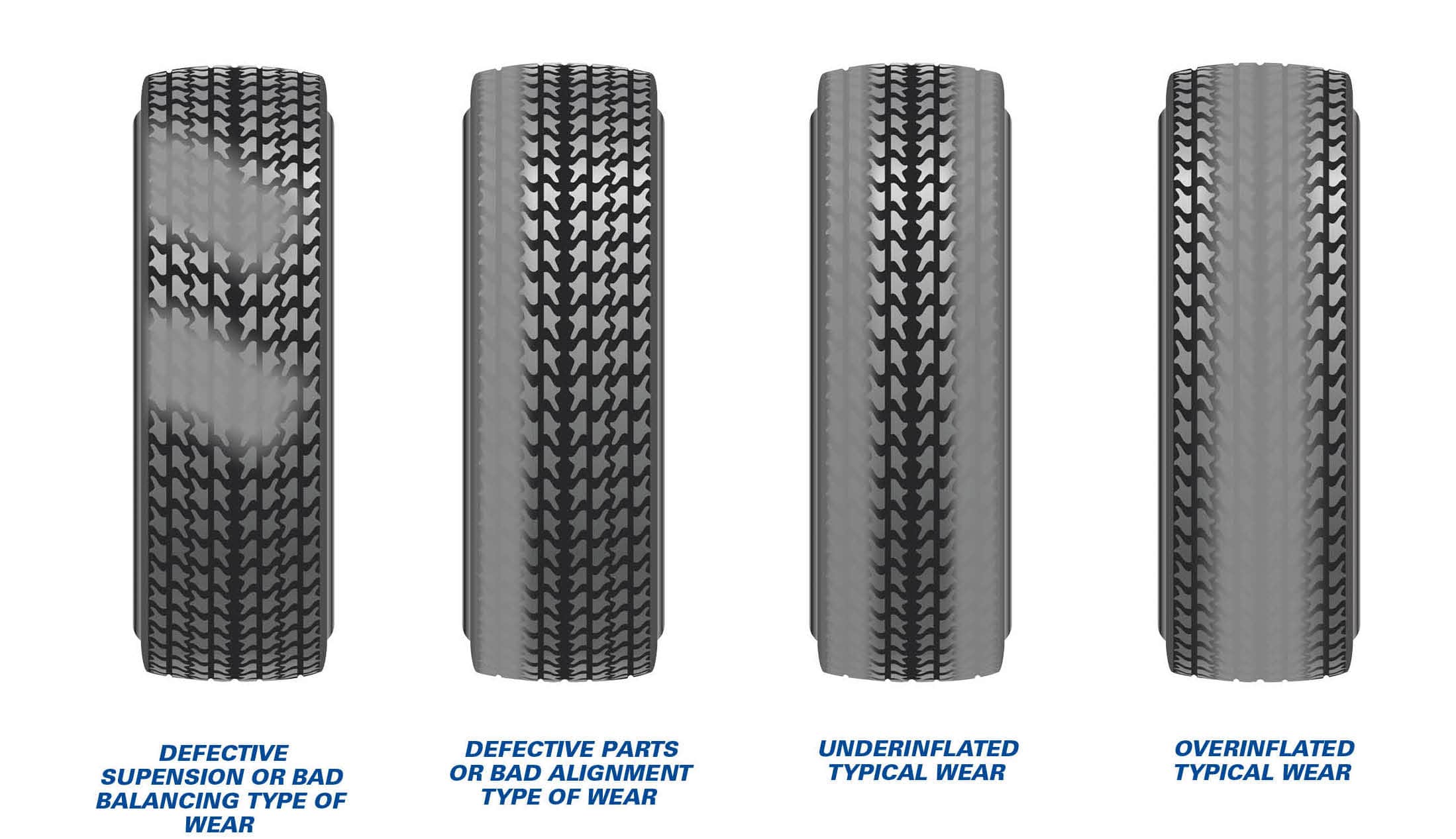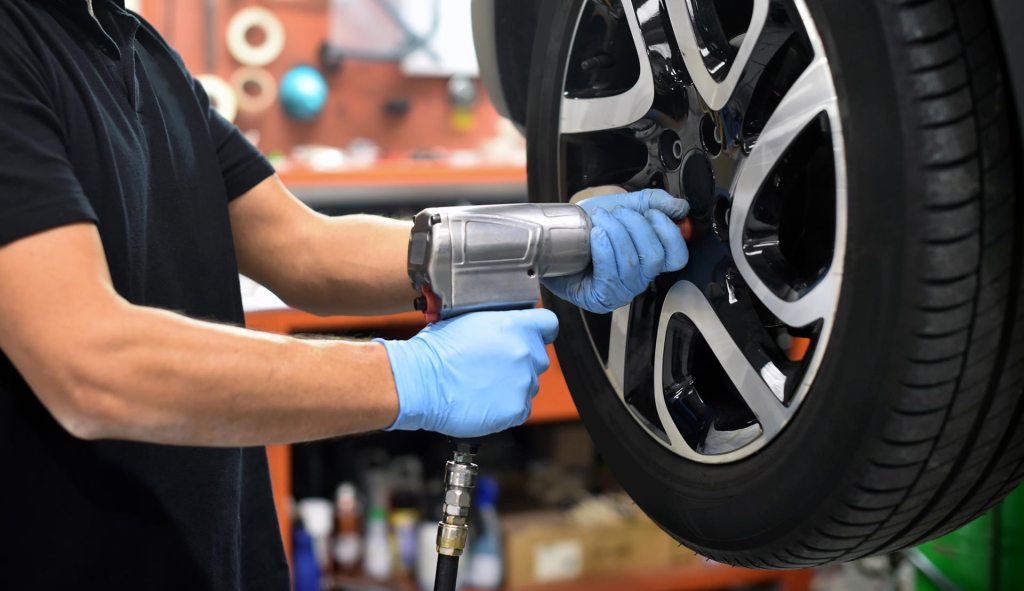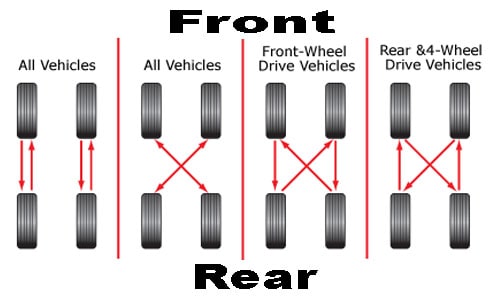How Often Should You Rotate Your Tires & Rotation Patterns?
Each and every component in your vehicle requires frequent maintenance and most require replacement at some point. Among the parts most subject to wear and tear is your tires. Of course they would need to be replaced at some point, but you can avoid premature replacement by rotating your tires to let them wear evenly. This comprehensive guide will give you the answer on how often should you rotate your tires and how to do this for different cars with different transmission layouts, that is 4WD, AWD, FWD and RWD, plus many useful maintenance tips.
Why Should You Rotate Your Tires?
Most drivers don’t pay attention to their car’s tires, as they are … boring and are not high-tech components. However, they are vital to your safety and driving experience, since they are the only parts of your car that come into contact with the road.
The state and the age of your tires can greatly affect your steering ability, handling and the car’s traction.
Unusual Tread Wear & What They Mean

Different problems result in unusual different tread wear patterns. By inspecting your tire’s tread wear pattern, you can learn important information on what might have gone wrong.
The three most obvious tread wear pattern is center wear, edge wear and inner/outer edge wear. Center wear is caused by consistent tire overinflation, which results in the center of the tire being in contact with the road. Wear on both the inner and outer edges means consistent under-inflation, which causes these parts to come into contact with the road the most. If the exaggerated wear is on either the inner or the outer edge, it means you have a misalignment problem.
Two other common tire problems from wear and tear include cupping and blistering of the sidewall.
Tire cupping, also called tire scalloping, is an uneven wear pattern, which occurs due to irregular up-and-down motions, or bouncing, of the wheels. This problem presents itself in the form of tread wear that appears in dips all over a tire’s tread edge.
It is more common in older vehicles with aging suspension systems. If ignored, this problem will make the tires wear out prematurely, and will impede the tire’s proper contact with the road, which would significantly affect a vehicle’s steering, handling and braking ability. In short, both your safety and your wallet are at risk here.
Another common wear and tear for tires is a blistered sidewall, which literally means a bulge or bubble in the sidewall. Bubbles or bulges in the sidewall are normally the result of a physical impact, most likely from slamming into a deep pothole. The tire’s inner liner gets damaged, creating a small hole or tear in the sidewall. Air could then get into the structure of the tire, and you get a blister.
This compromises the strength of the sidewall plies. If not dealt with in time, a bubble in the sidewall could result in a flat tire or a blowout, both of which could cause serious accidents.
On occasion, a sidewall bubble or bulge can be caused by a structural failure of the tire. This can be a result of aged tires that naturally deteriorate, even if you rarely drive at all.
Age
Tires are made of natural rubber, synthetic rubber and other chemical compounds. If you stretch a rubber band for a consecutive long period, it will develop tiny cracks all over and finally snaps. The same thing happens with a rubber band that has been sitting around for a long time idly: when you stretch it, it will crack.
Wear and tear for car tires is similar. The more you drive, the faster the tires age. Even if you rarely drive at all, the longer the tires are sitting there, the faster they age and deteriorate.
READ MORE
- Crack In Tires: Consequences That Can Be Life-Altering
- How To Fix Dry Rotted Tires: A Systematic Guide
How Tire Rotation Comes Into Play
Depending on whether your car is front-, rear-, or all-wheel drive, each tire will wear at a different rate due to different levels of usage. For example, in a front-wheel drive, the front wheels have to work much harder than the rear wheels: steering, braking, and withstanding the weight of the engine and front axle.
Periodically rotating your wheels will allow all four wheels to even out their wear, thus extending their lifespan a little longer as well as improving your drivability and safety.
How Often Should You Rotate Your Tires?

Professionals offer numerous schedules for tire rotation. Rotation at least once every six month is commonly recommended. Some tire manufacturing companies recommend changing tires after every 10,000-12,000 kilometers. That said, following the manual would be the ultimate choice.
Of course, how often should you rotate your tires also depends on many factors, and if your tires tend to wear faster than those of an average driver, adjust as you see fit to ensure your safety as well as drivability. Below are the top factors that affect how fast your tires wear.
Factors Affecting How Fast Tires Wear
Maintenance or conditions of use
If you’re a reckless driver, it’s no wonder your tire will age faster. If you tend to hit the curb, or drive on sharp pebbly roads, or have the habit of turning the steering wheel when your car is not moving at all, bless your tires.
Even inflating your tires requires some attention. An under-inflated tire will be in contact with the road more, thus more wear and tear. If your tire is punctured, make sure you have it properly repaired.
READ MORE
- Can You Inflate A Car Tire With Bike Pump?
- How Often Should You Put Air In Your Tires?
- Nitrogen Vs. Air In Tires – Which Is Better?
Type of road
Tires running on flat smooth roads will stay stronger for longer compared to tires running on bumpy, hilly or mountain roads.
In addition, tires on cars that travel mostly on the highway at constant speed with less stopping will last longer than those on vehicles that run around town, which have to stop frequently, slow down and accelerate due to traffic.
Environmental Impact: Heat & UV
According to the National Highway Traffic Safety Administration (NHTSA), tires deteriorate faster in hotter climates and when frequently in direct exposure to sunlight, like every other material on earth.
Direct exposure to UV breaks down the oils and chemicals in the tire, which keep the rubber flexible and durable, thus speed up the aging process.
If you have mounted your spare tire on the back of your car, it will age a little slower than the four wheels on the ground, however it is already exposed to heat, light and air, thus it is considered “in service” and still ages nonetheless.
Enhanced materials
Anti-ozonant chemical compounds, a type of additives for plastic and rubber, can be incorporated into the rubber to slow down the inevitable aging process to some extent. These anti-ozonants prevent cracking on plastic and rubber materials caused by the tiny amount of ozone in the air, thus their name comes from “anti” and “ozonant”.
These tires are often rated for higher mileage. Improved resistance to ozone cracking is a feature you should look for if you’re looking for tires that will last longer than average.
Tire Rotation Pattern for Different Transmission Layouts
All-, front- and rear-wheel drive, referring to different types of engine and transmission layouts. They are used in certain driving situations to ensure safety and ease in controlling the vehicle. Each system treats power sent to the tires in different ways, thus each has a distinct tire wear and thus these vehicles need different tire rotation patterns.
According to the Tire Industry Association, there are three tire-rotation patterns that cover most of today’s AWD, FWD and RWD vehicles, given that these vehicles are fitted with equal-size tires front and rear. Before performing a particular rotation pattern, check your manual to see if your tires are unidirectional, meaning they have to rotate in only one direction to function properly.

All-Wheel-Drive Vehicles
AWD is a full-time system that is “on” all the time and it either mechanically or electronically varies the amount of power sent to each wheel for optimal balance and drivability.
Subaru’s ad campaign sums up the advantage of the AWD very well: “transfers power from the wheels that slip to the wheels that grip.” When there is a loss of traction, power from the engine is transferred away from the slipping wheels to the other wheels, helping the car quickly regain traction, thereby improving fuel economy.
An important note is that while many think that AWD vehicles automatically have tires that wear more evenly than other types of drivetrains, this doesn’t mean you’re immune to uneven wear and can skip tire rotation.
This is because for one, the inherent weight difference between the front and rear of any vehicle can also affect tire wear. Secondly, all-wheel-drive systems don’t always drive all the wheels all the time. Remember that depending on the selected drive mode and the driving conditions, transfer cases and electronically controlled differentials can shift power between the front and rear wheels, creating uneven wear.
For AWD vehicles, the optimal pattern is criss-crossing: move the right front to the left rear, the left front to the right rear, the left rear to the right front, and the right rear to the left front. Another way to remember this is what is front will be rear, what is right will be left, and vice versa.
Front-Wheel-Drive Vehicles
While 4WD and AWD have been gaining popularity more recently, most cars on the roads typically have front-wheel drive, that is the engine’s power is transferred to the two front wheels only.
An advantage of a FWD car is better traction when climbing uphill, since the power is all in the front wheels. However, this also means lower traction compared to the AFW system in normal driving situations: if one of the two front wheels loses traction and slips, there is only one wheel left to find some grip.
For FWD, swap the front tires straight to the right rear position on the same side, that is right front to right rear and left front to left rear. Then, criss-cross for the rear tires: move the right rear tire to the left front and the left rear tire to the right front.
Rear-Wheel-Drive Vehicles
Rear-wheel drive is front-wheel drive in reverse. When you press on the gas pedal in a RWD vehicle, power is sent to the rear wheels, thus maximizing the car’s performance in acceleration. That is, the rear wheels provide force to move the car, while the front wheels decide its direction.
For RWD vehicles, the rotation pattern is also like that of FWD but in reverse. Move the rear tires straight to the front, that is left rear to the left front and right rear to the right front. Then move each front tire to the opposite rear corner, that is right front to the left rear and left front to the right rear.
Notes
The above tire rotation patterns will need to be adjusted if you’re dealing with a high-performance vehicle that has front and rear wheels of different sizes. Extra attention is also needed for vehicles fitted with unidirectional tires that are designed to rotate in one direction only.
In these situations, as well as with regular vehicles, should you have any doubts about the correct tire rotation, consult the owner’s manual, inquire at a dealership, or talk to a professional (even better is someone familiar with your vehicle and how you drive). But whatever you do, rotate them if possible. At the very least, it’ll help your tires last longer and will save you money.
Bonus: When To Replace Your Tire
How Long Do Tires Last?
Like other parts of your car, the answer varies with the tires quality, your driving conditions and how you use them. That said, there are general estimates for the average car tires lifespan.
Experts generally agree that you can expect your tires to last you at least 50,000 miles in normal driving conditions, an equivalent of which is around 3-4 years of driving. However, many car owners have complained that their new tires or replacement tires only last them some 20,000 to 30,000 miles.
In short, there are no promises. While you do not need to spend a lot on buying expensive tires, the best you can do is to do your research and grab some quality tires instead of the cheapest option available.
How to Know A Tire’s Age
Replace your tires when they get old and look for new tires with recent manufacturing dates.
You can determine the age or the year of manufacturing of a tire by looking for the Tire Identification Number (TIN) on the sidewall of any tire. The TIN will be the last group of digits in a longer group of letters and numbers following “DOT”.
An example of the DOT code is: DOT Y9RJ FPUU 2618. Each group of digits are separated by a space.
The last group of digits for this tire consists of 4 numbers, meaning the tire was manufactured after the year 2000. Specifically, it was manufactured in the 26th week of the year 2018, which means this tire is fresh and new.
Another example of the DOT code is: DOT JI3P FUM0 137.
The last group having 3 digits is “137”, denoting that the tire was manufactured in the 13th week of the year 1997.














